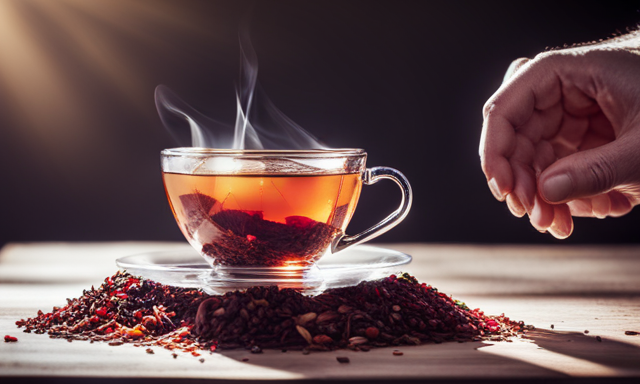I absolutely adore Starbucks’ Vanilla Rooibos Tea Latte. It’s like a warm, comforting hug in a cup. The combination of the rich vanilla flavor and the earthy notes of the rooibos tea creates a truly delightful experience for your taste buds.
If you’re wondering what goes into this heavenly beverage, look no further. In this article, I’ll guide you through the ingredients, step-by-step instructions, and even share some tips and tricks for customizing the recipe to your liking.
Whether you’re a tea aficionado or just looking to try something new, this Vanilla Rooibos Tea Latte will not disappoint. So grab your favorite mug and get ready to indulge in a homemade version of Starbucks’ beloved drink. Trust me, you won’t be able to resist its irresistible allure.
Key Takeaways
- The vanilla rooibos tea latte recipe can be customized with toppings, garnishes, flavored syrup, and alternative milk choices.
- Adding spices like cinnamon or nutmeg can add a cozy touch to the latte.
- Making your own tea latte at home allows you to control the ingredients and customize the flavors.
- Rooibos tea is a great alternative base for a latte, as it has a rich, earthy flavor and is packed with antioxidants, while also supporting digestion and heart health.
Overview of Starbucks’ Vanilla Rooibos Tea Latte
Starbucks’ Vanilla Rooibos Tea Latte offers a delightful blend of vanilla-infused rooibos tea, creating a soothing and aromatic beverage.
Rooibos tea, also known as red tea, is a caffeine-free herbal tea that comes from the Aspalathus linearis plant native to South Africa. It’s rich in antioxidants and has been associated with numerous health benefits, including improved digestion, reduced inflammation, and enhanced heart health.
Rooibos tea lattes have gained popularity in recent years, with different variations available to suit various taste preferences. Some variations include adding steamed milk, vanilla syrup, or even a touch of honey.
These lattes provide a comforting and warming experience, perfect for relaxing moments or chilly days.
Moving on to the ingredients needed for the recipe, we’ll discover the key components that make this latte a truly delicious treat.
Ingredients needed for the recipe
First, you’ll need to gather all the necessary ingredients for this delicious beverage. The star ingredient of the vanilla rooibos tea latte recipe is, of course, the rooibos tea itself. This tea is known for its numerous health benefits, including its high antioxidant content, which can help boost the immune system and improve overall well-being. Additionally, rooibos tea is naturally caffeine-free, making it a great alternative for those looking to reduce their caffeine intake.
In addition to the tea, you’ll need vanilla syrup, steamed milk, and whipped cream to complete this comforting drink. If you’re looking to switch things up, you can experiment with alternative ingredients such as almond milk or honey instead of vanilla syrup.
Now that you have all the ingredients, let’s move on to the step-by-step instructions for brewing the tea.
Step-by-step instructions for brewing the tea
Next, let’s dive into the simple steps for brewing this delightful beverage. To make a Starbucks Vanilla Rooibos Tea Latte, follow these brewing techniques and tea steeping methods:
-
Start by boiling water in a kettle or a pot.
- Use filtered water for the best taste.
- Boil enough water to fill your mug or cup.
-
Place a Vanilla Rooibos tea bag in your mug.
- Choose a high-quality tea bag for optimal flavor.
- Make sure the tea bag is fresh and not expired.
-
Pour the boiling water over the tea bag.
- Fill the mug about 2/3 of the way.
- Let the tea steep for around 5 minutes.
-
Remove the tea bag and add hot milk.
- Use your preferred type of milk, such as dairy or non-dairy.
- Pour the milk slowly while stirring gently.
Now that you’ve brewed the tea, it’s time to move on to the next section about adding the vanilla flavor.
Adding the vanilla flavor
To enhance the delightful flavor of your homemade beverage, prepare to be dazzled by the infusion of rich, velvety vanilla that’ll transport your taste buds to paradise. Adding vanilla extract is the key to achieving that signature Starbucks Vanilla Rooibos Tea Latte taste.
Start by adding a teaspoon of high-quality vanilla extract to your brewed tea. Stir it gently to ensure the vanilla is evenly distributed throughout the drink. If you wanna experiment with alternative vanilla flavorings, you can try using a vanilla bean or even vanilla-flavored syrup. These options can add a unique twist to your latte and allow you to personalize the flavor to your liking.
Now that we’ve added the vanilla, let’s move on to preparing the milk for the latte.
Preparing the milk for the latte
Now it’s time to get your milk ready for that perfect, creamy latte experience. Here are four essential steps to prepare your milk for the Starbucks Vanilla Rooibos Tea Latte:
-
Choose your milk: Starbucks offers a variety of milk options, including dairy and non-dairy alternatives like almond, soy, or coconut milk. Pick the one that suits your taste preferences and dietary needs.
-
Heat the milk: Pour your desired amount of milk into a saucepan and heat it over medium-low heat. Stir occasionally to prevent scorching until the milk reaches your desired temperature.
-
Frothing techniques: For a frothy latte, you can use a handheld frother or a milk frother machine. These tools create the perfect texture by incorporating air into the milk, resulting in a creamy foam layer.
-
Alternative milk options: If you prefer a non-dairy option, such as almond or soy milk, be aware that these alternatives may require different frothing techniques due to their composition.
Now that your milk’s ready, let’s move on to frothing it for a creamy texture.
Frothing the milk for a creamy texture
Get ready to create a velvety smooth texture by frothing your milk to perfection. Frothing techniques are essential for achieving that creamy consistency in your Starbucks Vanilla Rooibos Tea Latte.
Start by choosing the right milk for frothing. While whole milk is a classic choice, you can also experiment with alternative milk options such as almond, soy, or oat milk. Each type of milk will produce a slightly different texture and taste.
Once you have your milk of choice, pour it into a stainless steel frothing pitcher. Place the steam wand just below the surface of the milk and turn on the steam. Move the wand in a circular motion to create a whirlpool effect. This will incorporate air into the milk, resulting in a frothy and creamy texture.
Carefully monitor the temperature, as overheating can ruin the milk. Once your milk is perfectly frothed, you’re ready to combine it with the brewed tea for the perfect latte experience.
Combining the tea and milk for the perfect latte
Once the milk’s perfectly frothed, it’s time to blend it with the brewed tea for a luscious and indulgent latte experience. Imagine savoring the rich combination of the creamy frothed milk and the aromatic tea, creating a comforting and satisfying drink to start your day.
To achieve the perfect latte, follow these steps:
-
Slowly pour the frothed milk into the brewed tea, allowing the two to mix together seamlessly.
-
Use a spoon or whisk to gently stir the tea and milk, ensuring that they’re well combined.
-
Continue stirring until you achieve a smooth and creamy texture, with no separation between the milk and tea.
By combining the tea and milk in this way, you’ll create a deliciously balanced latte with a creamy texture and a delightful blend of flavors.
Now, let’s move on to the next section and explore optional toppings and garnishes to elevate your latte even further.
Optional toppings and garnishes
To take your indulgent drink to the next level, why not consider adding a sprinkle of cinnamon or a dollop of whipped cream as the perfect finishing touch? These optional toppings and creative garnishes can elevate your Starbucks Vanilla Rooibos Tea Latte recipe from delicious to extraordinary. Here are some ideas to inspire you:
| Topping/Garnish | Description |
|---|---|
| Cinnamon | A classic choice that adds warmth and depth to the flavor profile of the latte. Sprinkle a pinch on top of the whipped cream for a beautiful presentation. |
| Whipped Cream | Creamy and dreamy, a dollop of whipped cream on top of your latte adds a luxurious texture and a touch of sweetness. Feel free to get creative and drizzle some caramel or chocolate sauce over it. |
| Vanilla Bean | For an extra burst of vanilla flavor, scrape out the seeds from a vanilla bean and sprinkle them on top of your latte. This adds a visually appealing speckled effect and enhances the overall taste experience. |
By experimenting with different toppings and garnishes, you can personalize your Vanilla Rooibos Tea Latte to suit your taste preferences. Now, let’s move on to some tips and tricks for customizing the recipe.
Tips and tricks for customizing the recipe
When you really want to make this indulgent drink your own, try out some clever tricks and inventive ideas to put your unique spin on it. Here are a few customizing options to consider:
-
Add a splash of flavored syrup like caramel or hazelnut to enhance the sweetness and add depth to the flavor.
-
Experiment with alternative milk choices such as almond, coconut, or oat milk for a dairy-free version that suits your dietary preferences.
-
Incorporate spices like cinnamon or nutmeg to add a warm and cozy touch to your vanilla rooibos tea latte.
By exploring these customizing options, you can create a personalized beverage that perfectly suits your taste buds.
Now, let’s move on to the next section and learn about enjoying your homemade vanilla rooibos tea latte.
Enjoying your homemade Vanilla Rooibos Tea Latte
Now that you’ve learned some tips and tricks for customizing your Vanilla Rooibos Tea Latte recipe, let’s talk about how to fully enjoy your homemade creation.
There are many benefits to making your own tea latte at home. Not only does it allow you to control the ingredients and customize the flavors to your liking, but it also gives you the opportunity to explore homemade tea latte alternatives. You can experiment with different types of tea, such as green tea or chai, and add your favorite spices or sweeteners.
One great alternative to consider is using rooibos tea as the base for your latte. Rooibos tea is known for its rich, earthy flavor and numerous health benefits. It’s packed with antioxidants, can help improve digestion, and may even support heart health.
So go ahead, indulge in the comforting warmth of your homemade Vanilla Rooibos Tea Latte while reaping the health benefits of this delicious alternative.
Frequently Asked Questions
How many calories are in a Starbucks Vanilla Rooibos Tea Latte?
The calorie content of a Starbucks Vanilla Rooibos Tea Latte varies depending on the size and any added sweeteners. It is important to check the nutritional information for the specific drink you order.
Can I use a different type of tea instead of rooibos for this recipe?
Yes, you can use a different type of tea for the recipe. There are many different tea options that can be used, allowing for flavor variations. But, which tea will give you the perfect balance of flavors?
Can I make this recipe vegan by using non-dairy milk?
Yes, you can make a homemade vegan version of this recipe by using non-dairy milk. To froth the milk, I recommend using a handheld frother or a milk frother machine.
Can I make a decaffeinated version of the Vanilla Rooibos Tea Latte?
Yes, you can make a decaffeinated version of the vanilla rooibos tea latte. Starbucks offers decaffeinated alternatives, such as decaf rooibos tea, and you can still enjoy the same delicious flavor variations with non-dairy milk options.
Can I substitute the vanilla syrup with another sweetener, like honey or agave?
Yes, you can substitute the vanilla syrup in the vanilla rooibos tea latte with honey or agave. Both honey and agave add a natural sweetness and have additional health benefits like antioxidants and antibacterial properties.
Conclusion
In conclusion, brewing your own Starbucks Vanilla Rooibos Tea Latte at home is a delightful experience. The combination of the aromatic vanilla and the earthy rooibos tea creates a truly unique and satisfying flavor. By following the step-by-step instructions and adding your own personal touch, you can enjoy a customized latte that suits your taste perfectly.
So why not treat yourself to a warm and comforting cup of this delicious drink? It’s like a cozy blanket for your taste buds.










